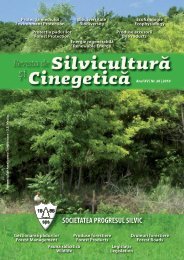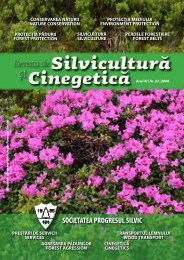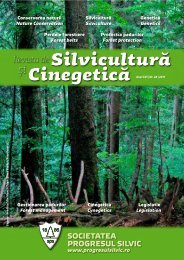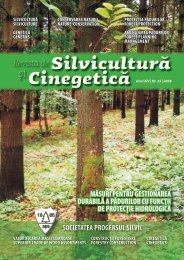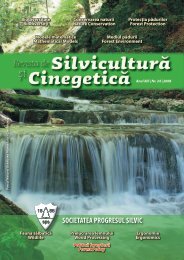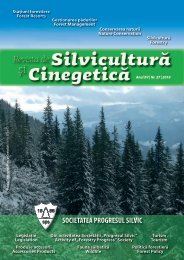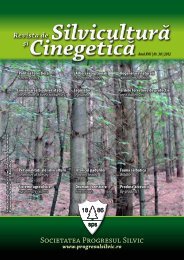Silviculture and Cinegetics Review - Societatea Progresul Silvic
Silviculture and Cinegetics Review - Societatea Progresul Silvic
Silviculture and Cinegetics Review - Societatea Progresul Silvic
Create successful ePaper yourself
Turn your PDF publications into a flip-book with our unique Google optimized e-Paper software.
FORESTRY BELTS SILVICULTURE AND CINEGETICS REVIEW XVII/30/2012<br />
mentioned for the first time in 924 AD, as a result of the<br />
thinning of oak forests by cutting, controlled fire <strong>and</strong><br />
grazing with goats. Trees were maintained in a certain<br />
proportion, so that from the same l<strong>and</strong> surface can be<br />
obtained the necessary wood, grass for grazing animals,<br />
cereal crops <strong>and</strong> others.<br />
complete ab<strong>and</strong>onment of transhumance, partial<br />
substitution of sheep with cattle due to lack of pastors,<br />
decrease in food stocks <strong>and</strong> grazing periods, allowed by<br />
the socio-economic adjustments of the agricultural<br />
politics are the most important factors for this situation<br />
(Olea, San Miguel, 2006).<br />
In time, goats were replaced by cattle, sheep, horses <strong>and</strong><br />
pigs. By maintaining optimum animal load per hectare<br />
throughout, this agroforestry system is kept under<br />
control <strong>and</strong> perfect ecological <strong>and</strong> economical balance<br />
for all its structural components:<br />
trees+pastures+animal+agricultural crops.<br />
2.2. Role of st<strong>and</strong> in the agroforestry system<br />
Dehesa is similar to African savannah (with dry<br />
summers, <strong>and</strong> not rainy like the typical savannah) where<br />
st<strong>and</strong> plays a fundamental role in the overall balance,<br />
<strong>and</strong> offering indirect services <strong>and</strong> goods. However, it<br />
contributes to the overall productivity of dehesa with<br />
acorns, sprouts, <strong>and</strong> supply of feed for animals, cork,<br />
mushrooms, pollen <strong>and</strong> many other resources.<br />
St<strong>and</strong> is an essential component in the dehesa, <strong>and</strong> as<br />
such management should be seen as integrated with the<br />
semi-natural pasture <strong>and</strong> animals.<br />
This is the most important approach to dehesa, since<br />
natural regeneration is poor or lacking. Almost<br />
Photo. 1. The role of st<strong>and</strong> in the agroforestry system<br />
In addition, the situation is even more difficult because<br />
of fewer trees due to the so-called “seca” (tree dryness<br />
due to attack of fungi dispersed by climatic, edaphic <strong>and</strong><br />
biological conditions) (Table 5).<br />
Table 5. Main characteristics of the Spanish dehesa st<strong>and</strong> <strong>and</strong> appropriate management type (by Olea <strong>and</strong> San Miguel,<br />
2006)<br />
Main role<br />
Stability: structure, l<strong>and</strong>scape, climate, reduce erosion, water <strong>and</strong> nutrients cycle, shelter,<br />
biodiversity, carbon fixation, culture etc. Perennial species can be considered as permanent<br />
forage species for livestock <strong>and</strong> wildlife.<br />
Species<br />
Quercus ilex rotundifolia ,(=Q.ilex ballota), Q suber (xerophytes <strong>and</strong> perennial), Quercus<br />
faginea, Q. pyreneica <strong>and</strong> other dominant species<br />
Density<br />
(15) 20- 100( 200) mature trees /ha<br />
Degree of crown coverage (5) 10-50 ( 70) %<br />
Degree of base coverage (stems)<br />
Production<br />
2-10 (15) m 2 /ha<br />
Firewood : 800-5000 kg/ha per one rotation (10-15 years)<br />
Acorn : (100) 200 – 600 (800) kg/ ha with differences between years<br />
Cork ( only Q. suber ) : 500 – 1500 (2000) kg/ha per one rotation (9-12 years)<br />
Branches from cutting: 400-1500 kg /ha/year.<br />
Planting seedlings is important in the colder climate dehesa where acorn production is lower.<br />
<strong>Silvic</strong>ultural rotation<br />
Treatments<br />
Areas of natural regeneration : st<strong>and</strong> senescence ( 150 years for Q. suber <strong>and</strong> 250-300 years<br />
for other species)<br />
Crown forming cuts in: 10-15 years<br />
Cork peeling in: 9-12 years<br />
The lack of st<strong>and</strong> natural regeneration in dehesa is by far the greatest threat to survival. In<br />
addition, “ seca” makes a lot of damages.<br />
2.3. The role of permanent pastures The most important managerial goal in a dehesa is<br />
extensive growth of animals. However, natural pastures,<br />
77



